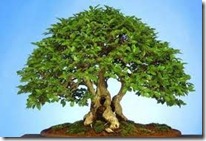 Beyond the basic styles of bonsai tree art, there are many wonderful variations and advanced styles of bonsai. The individual aesthetic that each artist brings to the work allows for an infinite variety of forms.
Beyond the basic styles of bonsai tree art, there are many wonderful variations and advanced styles of bonsai. The individual aesthetic that each artist brings to the work allows for an infinite variety of forms.
Group or Forest (Yose)
The group display, often called the forest, is just what the name suggests – multiple bonsai trees residing in a single container. Any species will do, but this style often contains all of one kind. Multiple species within a single pot would make soil design and watering management, not to mention climate and sunlight control, extremely difficult.
In the yose style, there are several sub-styles denoted by the number of trunks in the tray. Sambon-Yose (3 trunks), Gohon-Yose (5), Nanahon-Yose (7) and Kyuhon-Yose (9) are the most common and increasingly difficult as the number rises.
In some cases they spring from a single root underground, in which case the trunks are more like above-ground branches. This is termed kabudachi style of bonsai trees. The difference from a standard group in this case is that at the base there will be a central cluster in the middle of the pot.
Korabuki (Raft) Style
In nature, trees are not simply blown by wind and rain, but often completely knocked down. Rains softens the ground, roots grow close to the surface, and the earth has small underground holes. All conspire with the wind to undermine the ability of the tree to remain upright.
But trees are amazingly resilient and can adapt to survive under the most arduous conditions. Even when growing horizontally, provided there is adequate contact with the earth by the roots, life can continue.
As with most styles of bonsai trees, the bonsai artist attempts to emulate nature, even in this extreme case. Many of the results are as spectacular as the full-sized examples produced by nature alone.
Sub-styles include the ikadabuki (straight line), in which the trunk is entirely out of the soil. Typically it will rest on the surface, but some can actually grow somewhat like a kengai and are slightly above the ground.
In another sub-style the trunk of the bonsai trees rests at an angle, partially underground. In this case the bark under the earth will tend to decay from moisture and small soil organisms.
In many cases the trunk will be allowed to sprout multiple branches that look very much like individual trunks. These appear similar to a group or forest style, but all grow from a single tree.
The netsunagari (sinuous) style is one of the more exotic sub-types. Here the roots meander through the soil like many underground rivers and the trunks are highly gnarled and twisted.
The forms of bonsai trees are as varied as the artists who create them. Where the line is drawn between one style and another is often a very individual choice. After all, nature provides many examples of borderline cases. Dividing red from orange along the color spectrum is difficult. And, at what height does tall become average and fade into short?
Like many things in Japanese culture, the blending of apparent opposites, or balance among competing influences, is never more present than in the design and execution of indoor bonsai trees. It is the most traditional of arts combined with the ultimate in individual expression.

Deprecated: strpos(): Passing null to parameter #1 ($haystack) of type string is deprecated in /home/agriviek8Qv/agriviet.net/public_html/wp-includes/comment-template.php on line 2522